Publications
-
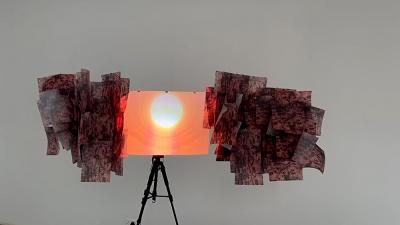
Born in Riyadh in 1970, Daniah Al Saleh reflects on cultural conditioning, questioning behavioral patterns and paradigms in everyday life. She examines elements we take for face value – the ordinary, the mundane, the ubiquitous in the mainstream – and reflects on these cultural tropes to draw out their relation to memory, connectedness, and division. In this way, she suggests alternative positions and perspectives. Her work is duplicitous: behind its aesthetics lies a commentary on human fragility, insecurity, and vulnerability. Daniah Al Saleh holds a Bachelor in Computer Applications from King Saud University, Riyadh, KSA, and has undertaken painting courses at Dar Safia Bin Zagr, Jeddah, KSA, and creative courses at the Prince’s School of Traditional Arts. In 2020 Al Saleh obtained an MFA in Computational Arts (with Distinction) from Goldsmiths university of London.
Her early projects were driven by symbols and Islamic geometry, using the recognizable patterns of traditional Islamic art to foreground surprising heroes. In one painting Pedestrian, 2016, the wooden spoon – regularly used in the kitchen, though seldom fêted – formed part of the work’s intricate pattern. These household items here assumed a pride of place that Al Saleh gently suggested as analogies for social constructs and cultural behaviors. Al Saleh’s work changed decisively when she did an MFA in Computational Arts from Goldsmiths in 2020. She began to work in new media, exploring how to integrate technologies as part of her practice in installations, such as the phonemes of the Arabic alphabet in Sawtam, which she used for her commission for the Ithra Art Prize in 2019, or the idea of collective versus personal memories of Saudi society, in her work That Which Remains, 2022, for the first Diriyah Biennale. In each, she exploits the capacity of the time-based medium to operate as a means of documentation, investigation, and speculation.
Selected exhibitions include forthcoming exhibition in ATHR Gallery, Al Ula, KSA (2024); Echoes of Time, Ahlam Gallery, Riyadh, KSA (Group Exhibition); Keep Smiling, ATHR Gallery, Jeddah, KSA, 2023 (Solo); Feeling The Stone, the First Ad-Diriyah Biennale In Saudi Arabia, Riyadh, KSA, 2022; Echoes. A World between the Analogue and the Virtual, BIENALSUR, Qasr Khuzam, Jeddah, KSA, 2021 (Group Exhibition) and the Artificial Intelligence and Intercultural Dialogue, The Hermitage Museum, St. Petersburg, Russia, 2019.
-
Born in 1986, is a contemporary artist based in Beirut. He holds a Bachelor’s degree in painting from the Faculty of Fine Arts at Damascus University and a Master of Arts degree from Kursk State University. Furthermore, he is currently completing a PhD in History and Philosophy of Art at Surikov Art Institute in Moscow.
Elias has been active on the Lebanese art scene since 2012. He has also exhibited at several solo and group shows in Europe, including in Lithuania, Russia, Poland,
Croatia and the Netherlands. His work is in private and public collections internationally, including the aforementioned countries as well as UAE, Syria, Lebanon, Egypt,
Bahrain, France, Denmark, Turkey and the United States. Elias Ayoub’s oeuvre a solid skill-set. His style ranges between Neo-Cubism and Neo-Expressionism, usually focusing on figures that have been stylized. The themes and subject matter that he chooses come from his background, heritage and life experiences in the Middle East.
-
Flavio Man was born in Tucuman, north of Argentina, in 1987. He lived in a small city between mountains, jungle, desert and buildings. This experience and contrasts are part of his art. After finishing High School in 2004 he studied Fine Arts in UNT, Tucuman. Years later he went to Buenos Aires to study film editing in ENERC. The art of the editing is important, because it is a dialog and a construction between images, generating sense and shape from different shots. He participated in several projects that were in festivals such as Cannes, Montreal. These years he attended an abstract art Workshop with Juan Astica, learning the language and expression of the abstract art. In the year 2018 he went into exile in Berlin. He currently lives there, working on exhibitions and creating new pieces of work.
-
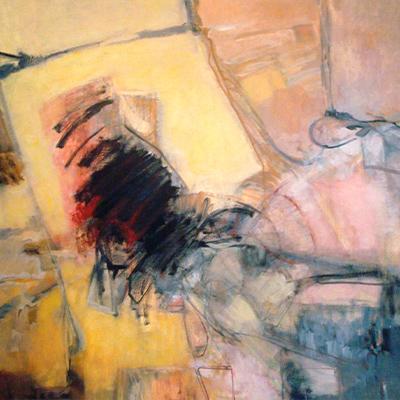
Born in Beirut, Lebanon in 1955, Ghada Jamal started painting in the early 80s and continued her studies at Beirut University College (LAU) later, she immigrated to United States of America to pursue graduate studies. In 1990, she earned Master degree in Fine Arts in Drawing and Painting from California State University Long Beach (CSULB ) and lived in California till her return to Lebanon in 2002.
Over the years, Ghada has exhibited in United States, Europe and the Middle East. She performed fourteen solo shows in Beirut, Lebanon and internationally.
She also participated in several group shows like "Contemporary Art" at City Center Dome, and "The Road To Peace" at Beirut Art Center. Her work is in many permanent collections,including the National Museum of Women in the Arts, in Washington, DC.
For over 17 years, Ghada Jamal taught drawing and painting at American University of Beirut (AUB) and Notre Dame University, Louize. She is currently living and working in the United States of America.
-
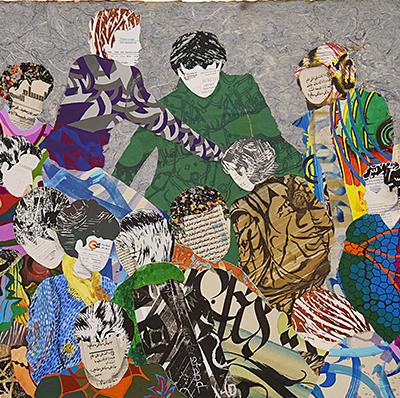
Haibat Balaa Bawab (b.1952) is a Lebanese artist renowned for her pioneering work in collage art. In
her pieces, namely her oil paintings additionally to her collage work, she intricately weaves narratives of
Beirut and its people, along with the scenic mountains and the country’s diverse beauty. The city where
she was born and raised continues to influence her work. Her observations of quotidian Beirut scenes
inspire her to translate these impressions into a distinctive artistic style.
Balaa’s main medium is an assemblage of fragments from popular sources—magazines, stamps, and
bills. She uses said media to map the cultural fabric of the city. By creating figurative images with
abstract elements, she draws on memories of village life, harvests, and bygone eras. Certain motifs
recur in her work; such as carpets, rugs, and oriental tapestries, evoking a sense of serenity and
nostalgia. Her subjects are a reflection of a range of social strata; from haute bourgeoisies’ opulent
houses to the vibrant floral and polychromatic patterns of peasants, refugees, and beggars. All of this
she achieves by using cut-outs as markers of identity and status.
“My artworks in collage and oil painting vary, encompassing cityscapes, local landscapes, heritage, and
nostalgia—reflections of daily life and topical issues. I’m inspired by my surroundings. Even when I
travel, my work mirrors my environment and mood,” Balaa states. Indeed, Balaa’s urban and natural
environments tend to permeate her artistic processes and manifest through her art.
Haibat Balaa received her BA in Fine Arts in 1975 from the Beirut University College [currently the
Lebanese American University]. She holds 17 years of teaching experience at the Lebanese American
University. She also took up the position of Fine Arts Coordinator at the American University of Science
and Technology (AUST) from 2001 until 2022.
Balaa has exhibited in numerous solo shows in Lebanon, Dubai, and Abu Dhabi. The various collective
exhibitions she has participated in include both local and international venues. Locally, these include the
American University of Beirut (AUB), LAU, ALBA, Haigazian, Station Des Arts, and the prestigious
Sursock Museum. Internationally, she has exhibited at Grand Palais de Paris, in addition to shows in
Cairo, Dubai, Abu Dhabi, Bahrain, and Kuwait. In 2019, she was invited to participate in the 8th Beijing
Biennale China.
Haibat Balaa Bawab is a member of the Lebanese Association of Painters and Sculptors as well as the
Artists Syndicate. Her artworks have appeared in publications including a monograph dedicated to her,
titled ‘Haibat Balaa Bawab: The Art of Collage’ (published 2012). Furthermore, she has authored two
AUST publications titled ‘Beyond the Medium I’ and ‘Beyond the Medium II’.
Balaa is an award-winning artist. In 1982, she was awarded the first and only prize by the Central Bank
of Lebanon for designing a new Lebanese currency. She also won first prize at the Makhoul exhibitions
of both 1979 and 1980. She continues to inspire artists and art-enthusiasts in her community.
-
Born in 1974 in Btedaï, in Lebanon’s Bekaa Valley, Imad Fakhry comes from a family of artists. He studied at the Académie Libanaise des Beaux-Arts (ALBA), and received his Master’s Degree from the Ecole Supérieure des Beaux-Arts de Cergy-Paris and the Ecole Nationale Supérieure des Beaux-Arts de Paris. Under the tutelage of French artist Yannick Guéguan, he pursued several courses and workshops in decorative painting and trompe l’oeil.
Imad Fakhry participated in several solo and group exhibitions in Lebanon and abroad, including in Switzerland, the United Kingdom, and the United States. In 2000, he was awarded the ABN AMRO Bank Prize, and in 2007, he was nominated for the Young Creative Awards at the Unesco in Beirut. In 2008, he represented Lebanon with his etchings and engravings at the Triennial of Rhodes, and in 2016, he won the Dr. Chaouki Chamoun prize.
Since 2003, the artist teaches drawing, sketching, etching and trompe-l’oeil at ALBA. .
-
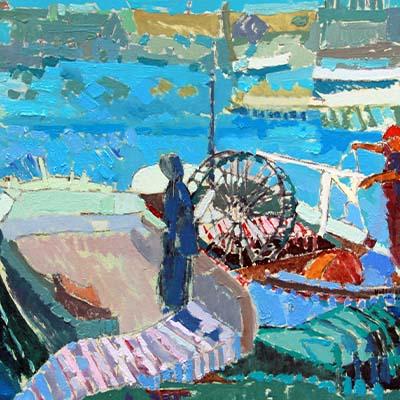
Born in Kuwait in 1968, Issa Halloum graduated from the Institue of Fine Arts at the Lebanese University in 1993, before pursuing studies in Artistic Anatomy at the Brera Academy in Milan in 1999.
Halloum seeks his inspiration in nature. He depicts intricately textured landscapes with vivid colours and airy configurations on canvases and on sculptures, where he plays with the surfaces and textures to create illusions of flatness. He paints from direct observation, carefully studying movement and light, engaging with these elements to create visual experiences rooted in the present moment. His palette is intense and expressive, revealing the significant influence of the great post-impressionist masters. As with Cézanne and Gauguin, he is generous with colors and his brushstrokes are energetic. Both calming and seductive, his paintings with simplified forms have a tangible feel. Whether he is painting a bright landscape, a busy market scene, an intimate view from a balcony, or an anonymous model, the artist freezes the action and the bustle. Additionally, his paintings are expansive. Landscapes and scenes are given room to flourish, creating the impression that the images outstretch the margin of the canvas, celebrating the abundance of nature, while carrying an aesthetic incompleteness that suspends the momentum of the compositions.
Halloum has participated in several individual and collective exhibitions across the Middle East and abroad, notably in Lebanon, Kuwait, Qatar, United Arab Emirates and Italy. His works are part of several regional and global private collections.
-
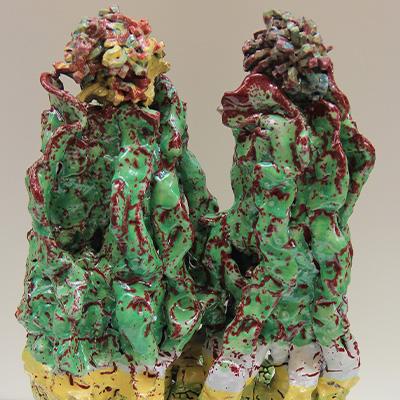
With him, the most ancestral of works becomes a modern art. Former Student of Teachers Training College, he specializes in psycho pedagogy at the Teachers Training College of Aix-En-Provence in 1955. Eager to knowledge, he follows up oriental studies and Islamology as well as Humanities at the Saint Joseph University, in addition to a BA in Management and Finances at the Lebanese University. Following that, he organizes trainings and activities in the manual pedagogic technology workshop at the Teachers Training College of Beirut. At the School of art crafts, he specializes in Ceramics and crown all this by a third cycle of research in “The handicraft production of actual ceramic in Lebanon, technical researches, stylistics and linguistics” at the Sorbonne in 1965. Ceramic requires knowledge in geography and geology in order to recognize the important sites for the extraction of clay, in history to be inspired thereby improve the old pieces, in sociology for the observation of the daily life, the manners and traditions of the craft-potter, and particularly in applied chemistry, since the clay is a hydrated alumina silicate. Multi-formation, double objectives: pedagogic and economic. On one hand, he aims at improving the life conditions of potters by developing and modernizing their profession. On the other hand, he brings technical assistance based on: the choice of raw materials used in the composition of the paste, the filtration of the ceramic slip by the sieve; improvement of the cleanness of the settling tank, diversification of the turned or modeled pieces, mechanization of the mixture of the clay with the raw materials and at last, encouragement of the creation of miniature pieces according to the need of the tourism market. His major concern was the improvement of the means, modes and frames in the same craft continuity. If it is needed to be more liberal in the production of functional pieces, Dr. Barchini was keen to save the style of the patrimonial pieces while following with caution the evaluation process.
-
Layla Dagher was born in Beirut, Lebanon. She studied Fine Arts at the Académie Libanaise des Beaux-Arts (Alba), and received her Master ’s Degree in Visual Art with honors. She has taken part in various group and solo exhibitions in Beirut, and her work has been featured in international shows in Tokyo, Seoul and Paris.
Her paintings are included in both private and public collections, notably at the Lebanese Ministry of Culture. Layla is a member of the Syndicate of Lebanese Artists, a professor in Fine Arts at the Notre Dame University (N.D.U), and currently lives and works in Beirut.
-
Daughter of Alfred Maalouf, a great Lebanese painter and visionary, Louna Maalouf grew up in a family and environment of artists. Since a young age, art has always been an essential part of her life. In 1988, she obtained her graduate diploma in Fine Arts from Lebanese Academy of Fine Arts (ALBA). Since 1989 and until now, she is committed to teaching at ALBA. She transmits to her students her artistic talent in schools of architecture and cinema. In 1997, Maalouf received a grant as a professor to pursue silkscreen printing and photography at the National School of Fine Arts in Cergy, Paris. She has participated in many group and solo exhibitions. Her work centers on the woman, the city and the citizen, and their role, identity and position in the world. A positive force emanates from her canvases, which portray the city she cherishes beyond all and from which she finds inspiration: Beirut.
-
Born in Lebanon in 1970, Mansour El Habre holds a Diploma in Plastic Arts from the Lebanese University and a
Masters in Plastic Arts from the Balamand University. He teaches Painting and Drawing at the Lebanese Academy
of Fine Arts (ALBA).
Since 1993, El Habre has participated in individual and group exhibitions in his hometown, Geneva,
London, Greece, Canada, Paris, Washington, Kuwait, Dubai, Abu Dhabi and Qatar. He has also been
invited by the Lebanese Ministry of Culture to participate in the International Triennial of Engraving
in Rodeos, Greece in 2008.
His work can be found in private and public collections including in the Audi Bank in Beirut, the
Solidere Headquarters in Beirut and the Cité Social de Fameck, France.
-
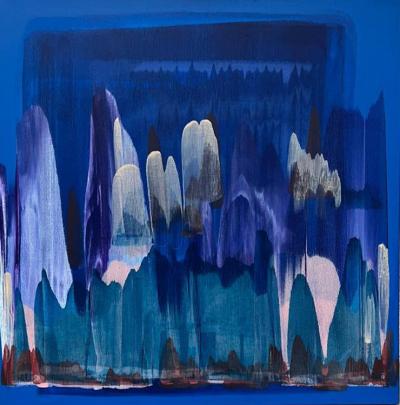
Rana Raouda, born in Beirut in 1961, is an accomplished artist whose educational journey led her through the paths of fine arts. She initiated her academic pursuit at the Lebanese American University of Beirut (LAU), where she graduated in 1983. Continuing her artistic studies, she cultivated her artistic expertise at prestigious institutions such as the Corcoran School of Art in Washington D.C, the Torpedo Factory in Virginia, and the Monotype Workshop in New Mexico.
Fluently expressing her love for nature through abstract forms, Rana Raouda's vibrant canvases exude joy and happiness. Working with acrylics on canvas, she creates multiple layers, often in various tones of the same color, infusing each painting with a sense of depth and movement. Her inspiration draws from life and nature, yet she constantly paints from memory. “When I start a painting I do not plan the entire composition. The desire to express myself comes from within and what my brush conveys are moments that I have captured in my mind’s eye.”
Rana Raouda's artistic talent transcends borders, as she has successfully displayed her work internationally, earning recognition in Italy, France, England, Switzerland, Jordan, and the United Arab Emirates. Her artistic journey is marked by notable achievements. In 1997, she received the Young Artist award at the Salon d’Automne held at the Sursock Museum in Beirut. In 2007, her talents were acknowledged with first prizes in Ornans, France, and Montreux, Switzerland. In 2013, Rana Raouda received the prestigious Golden Painting Prize from the National Federation of French Culture for her remarkable creations. Her artistic legacy continues to thrive, with her work finding a permanent place in the esteemed collection of the Sursock Museum in Beirut, a testament to her enduring impact on the world of art, as well as in numerous private collections worldwide.
“The burning desire to express my soul ignites from within, and what my brush conveys are the ethereal instants etched in the canvas of my mind."
-
Born in 1974, Safa Al Set studied at the Faculty of Fine Arts at Damascus University and graduated in 1997. She briefly experienced with multi-media graphic design, then decided to start her own artistic career, working with metal, using steel and copper as a means to create original art pieces, which stand out for their rough texture and design. She has brilliantly succeeded, repetititevely, in bringing metal to life; she is able to transform the hard nature of the metal into art that is alive and flowing. Safa Al Set plays with fire. In her Damascus studio, the lively artist heats and melds scrap pieces of iron and copper to form giant sculptures.
-
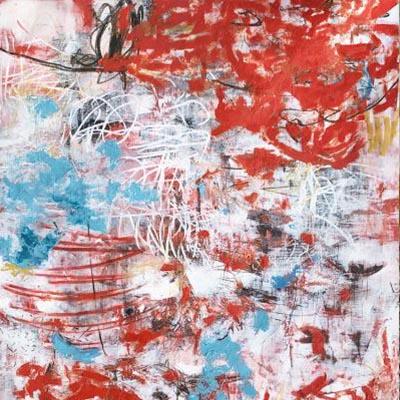
Born in Miami FL Sara is a Lebanese Visual Artist whose practice spans drawing, painting and video art. She has participated in several collective and solo exhibitions in Lebanon, Copenhagen, Berlin, and Canada including her upcoming participation in the collective “Lumiere du Liban” at the Arab Wprld Institute in Paris, were the work will enter the collection of the Institute Reading into the works of Sara Chaar is like jumping head on into a rumbling stream of consciousness, inhabited by insect-like creatures created with instinctual marks, transferring her impulses and feelings directly onto the work.
The process is a cycle of constructing, deconstructing and reconstructing, echoing the never-ending story of Beirut. With construction tools, she accumulates layers of paint and material that work as a foundation that she later on scratches through with screwdrivers, cutters and palette knives, instinctively forcing out transformations leaving behind the memory of her gesture. It is with these textures or realities that Chaar confronts her abstract work. Her work’s aim is to bridge the gap between her poetry and the reality that surrounds her, to discover textures from her environment that tell her a story that belongs to her and that she wants to decipher through her paintings. Out of another crisis, the pandemic, a shattered economy and an uncertain future came a need to put things into a new perspective, in this case a fictional perspective where she uses bold colors as a statement that she likes to call “Imagined Certainty”.
-
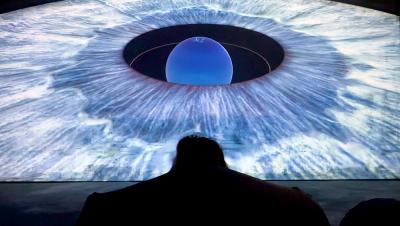
Striving for balance and harmony is the impetus behind Kova’s artistic mind, works and projects.
Researching human and environmental capacities, and the impact of the five senses on the perception of reality, Kova ontologically creates her videos, installations and performances to experience a quantum leap to the 5D state of consciousness, through the immediate activation of feel-good energy that is in alignment with the intuitive feminine principle.
Born in Vladivostok (USSR), Viktoria Kova spent her early childhood in Germany. Back in Russia, after graduating from the Russian State Institute of Culture, she moved to Amsterdam, where she launched her international career as a successful DJ vocalist and live-act performer.
Kova’s background, extensive traveling, and encounter with many cultures have triggered her fascination with the theme of perception, especially those linked with the environment. This has inspired her to become an ontological video artist, with the aim of reshaping the way humans perceive reality.
In 2015, pushing the boundaries between assumption, reality, and technology, Kova conceived the LAND of GOOD project, where she investigates the “better world” phenomena. Together with the interdisciplinary team of LAND of GOOD, based in Amsterdam, she seeks to ontologically confluence art, design, technology, science, and the natural world to increase viewers’ positive vibrations.
LAND of GOOD is an ongoing ontological research project that promotes the possibility for a prosperous, harmonious and sustainable society for everybody in our reality and beyond.
Rooted in research, Kova’s videos, installations and guided experiences are showcased in exhibitions at museums, galleries, and art fairs around the world.
LAND of GOOD is presented via Kova’s multimedia works, installations and talks, centred around her video art. Her works are included in private and corporate art collections in The Netherlands, Russia, USA, Lebanon, China, the United Arab Emirates and in the ALBA Museum in Beirut.
-
Born in Beirut, Lebanon, in 1961, Wissam Beydoun received his bachelor of art from the Lebanese American University (LAU) with the Sheikh Zayed Award distinction.
Beydoun works with organic forms, creating abstract landscapes that celebrate the majesty of mountains and the overall beauty of nature. His recent oeuvre revolves around his relationship with his hometown. Experimenting with the art of cartography, he maps out Beirut according to his experiences, documenting the emotions embedded in this metamorphic city.
Beydoun has held several individual and collective exhibitions in Lebanon and France, and has participated in Sursock Museum’s ‘Salon d’Automne’. His work is featured in numerous private collections.
|
|
